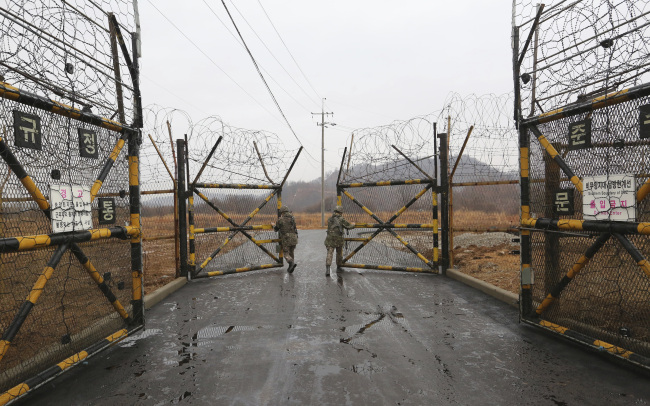Entering buffer zone near DMZ to be simplified for civilians
By Yeo Jun-sukPublished : Dec. 5, 2018 - 16:01
The South Korean government on Wednesday pledged to simplify the process for civilians to enter the restricted border region, as a part of efforts to lift the ban on developing the military-controlled area amid an inter-Korean detente.
The Ministry of National Defense and the ruling Democratic Party said they will establish an automated identification system by 2022 for those who want to cross the line that restricts civilians from entering the buffer zone near the heavily fortified Demilitarized Zone.
The Civilian Control Line was established in 1954 by the US Army to protect military facilities and operations at the end of the Korean War. The line extends about 10 kilometers south of the Military Demarcation Line that divides the two Koreas.
“We are going to conduct accurate, prompt identification on visitors to the Civilian Control Line,” said South Korea’s Joint Chiefs of Staff. “We will monitor the system to minimize people’s inconvenience as much as we can.”

The strict identification process has faced criticism among those who want to cross the restricted line for tourism and agricultural purposes. Visitors are required to undergo thorough inspection by the military units stationed at the border region.
The government seeks to expand the use of the Radio Frequency Identification system to speed up the entrance process. The advanced identification equipment will be installed at all military posts that control civilian access to the restricted area.
The RFID system allows users to automatically identify and recognize information by tracking tags attached to objects. Although the system is being used by some local municipalities, it has yet to be expanded nationwide due budget constraints.
“About 30,000 visitors a year will enjoy the benefit of having the waiting time reduced,” Rep. Kim Tae-nyeon of the Democratic Party said in a statement. Kim is one of the lawmakers who crafted the plan.
The simplification of the identification process came as the ruling party and government agreed to lift the designation of some restricted zones that host military facilities in provinces near the border with North Korea.
Both sides said Wednesday they decided to lift the classification of zones in 21 places with a total area of some 337 million square meters. They said it is the largest such action since the decision in 1994 to lift the designation of areas that total 1.7 billion square meters.
The affected areas are mostly located in the border towns in Gangwon and Gyeonggi provinces. Land development is restricted in the zones, and residents face restrictions in exercising their property rights.
“Construction and development are possible without consultation with the military in areas where the restriction on military facilities is lifted,” said Kim. “We believe that the measure will boost the local economy.”
South Korea has taken a series of measures aimed at reducing tensions with North Korea in the cross-border region. Last month, the two Koreas demolished 20 front-line guard posts scattered across the DMZ.
(jasonyeo@heraldcorp.com)








![[Graphic News] More Koreans say they plan long-distance trips this year](http://res.heraldm.com/phpwas/restmb_idxmake.php?idx=644&simg=/content/image/2024/04/17/20240417050828_0.gif&u=)
![[KH Explains] Hyundai's full hybrid edge to pay off amid slow transition to pure EVs](http://res.heraldm.com/phpwas/restmb_idxmake.php?idx=644&simg=/content/image/2024/04/18/20240418050645_0.jpg&u=20240419100350)





![[From the Scene] Monks, Buddhists hail return of remains of Buddhas](http://res.heraldm.com/phpwas/restmb_idxmake.php?idx=652&simg=/content/image/2024/04/19/20240419050617_0.jpg&u=20240419175937)

![[KH Explains] Hyundai's full hybrid edge to pay off amid slow transition to pure EVs](http://res.heraldm.com/phpwas/restmb_idxmake.php?idx=652&simg=/content/image/2024/04/18/20240418050645_0.jpg&u=20240419100350)

![[Today’s K-pop] Illit drops debut single remix](http://res.heraldm.com/phpwas/restmb_idxmake.php?idx=642&simg=/content/image/2024/04/19/20240419050612_0.jpg&u=)